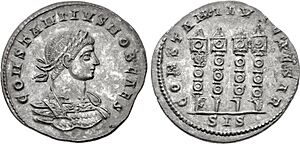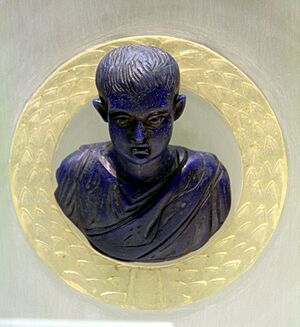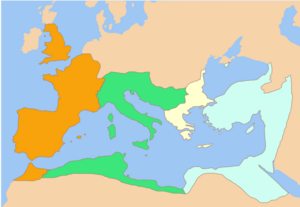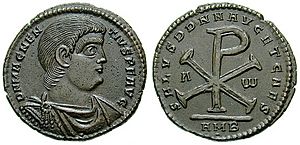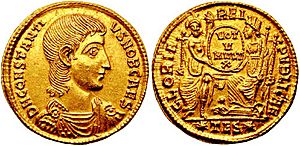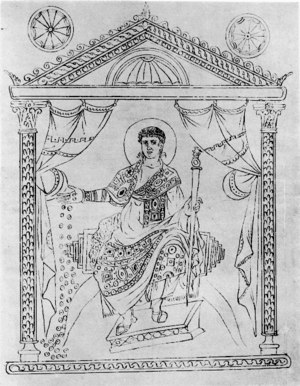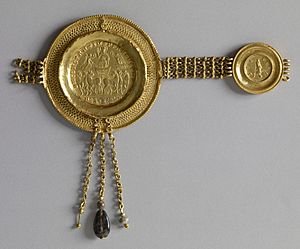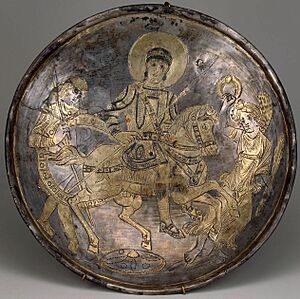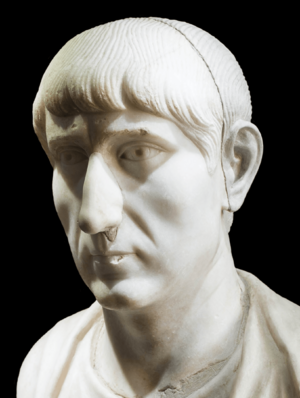Constantius II facts for kids
Quick facts for kids Constantius II |
|||||||||
|---|---|---|---|---|---|---|---|---|---|

Head portrait of Constantius II found in modern al-Bab, Syria (Penn Museum)
|
|||||||||
| Roman emperor | |||||||||
| Augustus | 9 September 337 – 3 November 361 | ||||||||
| Predecessor | Constantine I | ||||||||
| Successor | Julian | ||||||||
| Co-rulers | Constantine II (337–340) Constans I (337–350) Magnentius (350–353) Vetranio (350) Constantius Gallus (351-354) Julian (360–361) |
||||||||
| Caesar | 8 November 324 – 9 September 337 | ||||||||
| Born | 7 August 317 Sirmium, Pannonia Inferior |
||||||||
| Died | 3 November 361 (aged 44) Mopsuestia, Cilicia |
||||||||
| Burial | Church of the Holy Apostles | ||||||||
| Spouse | Daughter of Julius Constantius Eusebia Faustina |
||||||||
| Issue | Constantia (wife of Gratian) | ||||||||
|
|||||||||
| Dynasty | Constantinian | ||||||||
| Father | Constantine the Great | ||||||||
| Mother | Fausta | ||||||||
| Religion | Semi-Arianism | ||||||||
Constantius II (born August 7, 317 – died November 3, 361) was a Roman emperor who ruled from 337 to 361 AD. His time as emperor was filled with constant wars. He fought against the Persians and various Germanic peoples along the borders of the Roman Empire. Inside the empire, there were many civil wars and political struggles. His decisions about religion also caused conflicts that continued even after he died.
Constantius was a son of Constantine the Great, a very famous Roman emperor. His father made him a Caesar (a junior emperor) in 324. After Constantine the Great died in 337, Constantius became an Augustus (a senior emperor) along with his brothers, Constantine II and Constans. To secure his power, Constantius quickly made sure his family members who might challenge him were no longer a threat. The brothers then divided the empire. Constantius took control of the eastern parts, including Greece, Thrace, the Asian provinces, and Egypt.
For the next ten years, Constantius was busy fighting a difficult war against Persia. Meanwhile, his brothers Constantine II and Constans fought over the western parts of the empire. Constantine II died in 340, leaving Constans as the sole ruler of the west. Constantius and Constans managed to keep a difficult peace until 350. That year, Constans was overthrown and killed by a rebel named Magnentius.
Constantius refused to accept Magnentius as a co-ruler. He started a civil war against him. Constantius defeated Magnentius in major battles, including Mursa Major in 351 and Mons Seleucus in 353. In 351, Constantius made his cousin Constantius Gallus a Caesar to help rule the east. However, Constantius had Gallus executed three years later because of reports about his violent and corrupt behavior. In 355, Constantius promoted his last remaining cousin, Julian, to the rank of Caesar.
As emperor, Constantius supported a Christian belief called Arianism. He also banned pagan sacrifices and made laws against Jews. His military campaigns against Germanic tribes were successful. He defeated the Alamanni in 354 and fought against the Quadi and Sarmatians along the Danube river in 357. The war with the Persians restarted in 359. Constantius went east in 360 to bring back stability after losing some border forts. However, Julian claimed the title of Augustus in 360, leading to a conflict between them. Constantius tried to convince Julian to step down, but he failed. No battle was fought, as Constantius became ill and died of a fever on November 3, 361. He supposedly named Julian as his rightful successor before his death.
Contents
Constantius's Early Life and Rise to Power
Constantius was born in 317 in Sirmium, a city in Pannonia. He was the third son of Constantine the Great. His mother was Fausta, the daughter of Maximian. Constantius was made Caesar by his father on November 8, 324.
In 336, there was religious unrest in Armenia. Tensions also grew between Constantine and King Shapur II of Persia. This led to war between Rome and Sassanid Persia. Constantine became ill, so he sent Constantius to command the eastern border. Before Constantius arrived, a Persian general named Narses captured Amida in Mesopotamia. Constantius quickly attacked Narses, defeating and killing him at the Battle of Narasara. Constantius then recaptured Amida and began to rebuild its defenses. He also built a new fort nearby called Antinopolis.
Becoming Emperor in the East
In early 337, Constantius rushed to Constantinople because his father was dying. After Constantine died, Constantius buried him with a grand ceremony. Soon after, Constantius reportedly ordered the removal of relatives who might challenge his power. This event is not fully clear, but it helped him secure his position.
After this, Constantius met his brothers in Pannonia to officially divide the empire. Constantius received the eastern provinces, including Constantinople, Thrace, Asia Minor, Syria, Egypt, and Cyrenaica. His brother Constantine II received Britain, Gaul, Hispania, and Mauretania. Constans, who was initially supervised by Constantine II, received Italy, Africa, Illyricum, Pannonia, Macedonia, and Achaea.
Constantius then quickly went east to Antioch to continue the war with Persia. While he was away, King Shapur II attacked Roman territory. He laid waste to Mesopotamia and besieged the city of Nisibis. Shapur eventually lifted the siege. When Constantius heard this, he prepared his army for a counter-attack.
Constantius successfully defended the eastern border against repeated invasions by the Sassanid Empire under Shapur. These conflicts mostly involved the Persians besieging major Roman forts in Roman Mesopotamia, like Nisibis (Nusaybin), Singara, and Amida. Although Shapur often won these battles, the Persians gained little land. The Romans, however, won a key victory at the Battle of Narasara, where Shapur's brother Narses was killed. Constantius managed to push back the invasion, and Shapur failed to make any lasting gains.
Meanwhile, Constantine II wanted to control Constans's lands, leading to a conflict between them. Constantine was killed in 340 near Aquileia. As a result, Constans took control of his deceased brother's territories. He became the sole ruler of the western two-thirds of the empire. This division lasted until 350, when Constans was killed by forces loyal to a rebel named Magnentius.
War Against Magnentius
As the only surviving son of Constantine the Great, Constantius believed he was the rightful emperor. He decided to march west to fight the rebel, Magnentius. However, he felt the east still needed an emperor. So, he made his cousin Constantius Gallus a Caesar for the eastern provinces. To ensure Gallus's loyalty, Constantius married his older sister, Constantina, to him.
Before facing Magnentius, Constantius first dealt with Vetranio. Vetranio was a loyal general in Illyricum who had recently been declared emperor by his soldiers. Vetranio immediately sent letters to Constantius promising his loyalty. Constantius may have accepted this to prevent Magnentius from gaining more support. Constantius sent Vetranio the imperial crown and recognized him as Augustus. However, when Constantius arrived, Vetranio willingly gave up his position. He accepted Constantius’s offer of a comfortable retirement.
In 351, Constantius fought Magnentius in Pannonia with a large army. The Battle of Mursa Major was one of the biggest and bloodiest battles ever between two Roman armies. Constantius won, but it was a very costly victory. Magnentius survived and retreated into northern Italy. Instead of chasing him, Constantius focused on securing the Danube border. He spent early 352 fighting the Sarmatians there. After achieving his goals, Constantius advanced on Magnentius in Italy. This caused Italian cities to switch their loyalty to Constantius. Magnentius again retreated, this time to southern Gaul.
In 353, Constantius and Magnentius met for the last time at the Battle of Mons Seleucus in southern Gaul. Constantius won again, ending Magnentius's rebellion.
Sole Ruler of the Empire
Constantius spent much of 353 and early 354 fighting the Alamanni on the Danube border. This campaign was successful, and their raids stopped for a while. Meanwhile, Constantius received worrying reports about his cousin Gallus. Because of these reports, Constantius made peace with the Alamanni and traveled to Mediolanum (Milan).
In Mediolanum, Constantius first called for Ursicinus, Gallus’s military commander. Then, he summoned Gallus and Constantina. Gallus and Constantina started their journey, but when Constantina died, Gallus hesitated. However, after being convinced by one of Constantius’s agents, Gallus continued his journey west. He traveled through Constantinople and Thrace to Poetovio (Ptuj) in Pannonia.
In Poetovio, Gallus was arrested by Constantius's soldiers. Gallus was then moved to Pola and questioned. He claimed that Constantina was to blame for all the problems in the eastern provinces. This angered Constantius so much that he ordered Gallus's execution. He soon changed his mind, but the second order was delayed by one of Constantius's officials. Sadly for Gallus, he was executed.
Religious Policies
Paganism
Laws from the 350s made it a crime punishable by death to perform or attend pagan sacrifices. Worshipping idols was also banned. Pagan temples were closed, and the Altar of Victory was removed from the Senate meeting house. Christians often destroyed or damaged ancient pagan temples and monuments. However, many people still followed paganism. Governors and officials often did not strictly enforce the emperor's laws against it.
Despite these actions, Constantius never tried to get rid of the Roman priestly groups or the Vestal Virgins. He also did not act against pagan schools. Sometimes, he even tried to protect pagan traditions. He remained the pontifex maximus (chief priest) and was honored by the Roman Senate after his death. His moderate approach to paganism is shown by the fact that it was not until over twenty years after his death that any pagan senator complained about his treatment of their religion.
Christianity
Constantius is often seen as a supporter of Arianism. However, he actually preferred a middle ground between Arianism and the Nicene Creed, which is now called Semi-Arianism. During his rule, he tried to make the Christian church follow this compromise. He organized several Christian councils to achieve this. Historians note that the religious leaders he listened to were later discredited. The people he pressured to conform eventually won out. Because of this, the major church councils he held are not recognized as official by the church. Constantius II is remembered as a heretic who forced his will on the church.
Judaism
Judaism faced some strict rules under Constantius. He seemed to follow a policy against Jews, similar to his father's. This included laws to limit Jewish people owning slaves and banning marriages between Jews and Christian women. Later laws tried to stop conversions from Christianity to Judaism by taking away the property of those who converted. However, Constantius's actions might have been more about business competition than religion. Jewish businesses often competed with state-owned ones. So, Constantius might have wanted to help state-owned businesses by limiting skilled workers and slaves available to Jewish businesses.
New Challenges and Julian's Rise
On August 11, 355, a military commander named Claudius Silvanus rebelled in Gaul. Silvanus had surrendered to Constantius after the Battle of Mursa Major. Constantius had made him a commander in 353 to stop German threats. Silvanus achieved this by bribing the German tribes with money he had collected. A plot by members of Constantius's court led the emperor to recall Silvanus. After Silvanus rebelled, he received a letter from Constantius calling him to Milan, but it did not mention the revolt. Ursicinus, who was supposed to replace Silvanus, bribed some troops, and Silvanus was killed.
Constantius realized that the Empire still faced many threats. He could not handle all of them alone. So, on November 6, 355, he promoted his last remaining male relative, Julian, to the rank of Caesar. A few days later, Julian married Helena, Constantius's last surviving sister. Constantius soon sent Julian to Gaul.
Constantius spent the next few years managing affairs in the western part of the empire from his base in Mediolanum. In 357, he visited Rome for the only time in his life. That same year, he drove out Sarmatian and Quadi invaders from Pannonia and Moesia Inferior. He then led a successful counter-attack across the Danube.
In the winter of 357–58, Constantius received ambassadors from Shapur II. They demanded that Rome return lands given up by Narseh. Constantius rejected these terms but tried to avoid war with the Sassanid Empire by sending two embassies to Shapur II. Nevertheless, Shapur II launched another invasion of Roman Mesopotamia. In 360, Constantius learned that Shapur II had destroyed Singara (Sinjar) and taken other forts. He decided to travel east to face this new threat.
Julian's Rebellion and Eastern Troubles
Meanwhile, Julian had won some victories against the Alamanni, who had invaded Roman Gaul again. However, when Constantius asked for soldiers from Julian's army for the eastern campaign, the Gallic legions rebelled. They declared Julian Augustus.
Because of the immediate Persian threat, Constantius could not directly respond to his cousin's rebellion. He only sent messages trying to convince Julian to give up the title of Augustus and be content with being Caesar. By 361, Constantius saw no choice but to fight Julian. Yet, the threat from the Persians remained. Constantius had spent part of early 361 trying to retake a fort without success. He then retreated to Antioch to regroup and prepare for a fight with Shapur II. The previous year's campaigns had caused heavy losses for the Persians, so they did not launch another attack that year. This temporary break in fighting allowed Constantius to focus on Julian.
Constantius's Death
Constantius immediately gathered his forces and headed west. However, by the time he reached Mopsuestia in Cilicia, it was clear he was very ill. He would not survive to face Julian. Sources say that realizing his death was near, Constantius was baptized. He then declared that Julian was his rightful successor. Constantius II died of a fever on November 3, 361.
Like Constantine the Great, he was buried in the Church of the Holy Apostles. His sarcophagus was made of porphyry stone.
Marriages and Children
Constantius II was married three times:
- First, to a daughter of his half-uncle Julius Constantius. Her name is unknown. She was a full-sister of Gallus and a half-sister of Julian. She died around 352 or 353.
- Second, to Eusebia, who was from Thessalonica. Constantius married her before his victory over Magnentius in 353. She died in 360.
- Third and last, in 360, to Faustina. She gave birth to Constantius's only child, a daughter named Constantia. Constantia was born after her father's death and later married Emperor Gratian.
Family Tree
|
|||||||||||||||||||||||||||||||||||||||||||||||||||||||||||||||||||||||||||||||||||||||||||||||||||||||||||||||||||||||||||||||||||||||||||||||||||||||||||||||||||||||||||||||||||||||||||||||||||||||||||||||||||||||||||||||||||||||||||||||||||||||||||||||||||||||||||||||||||||||||||||||||||||||||||||||||||||||||||||||||||||||||||||||||||||||||||||||||||||||||||||||||||||||||||||||||||||||||||||||||||||||||||||||||||||||||||||||||||||||||||||||||||||||||||||||||||||||||||||||||||||||||||||||||||||||||||||||||||||||||||||||||||||||||||||||||||||||||||||||||||||||||||||||||||||||||||||||||||||||||||||||||||||||||||||||||||||||||||||||||||||||||||||||||||||||||||||||||||||||||||||||||||||||||||||||||||||||||||||||||||||||||||||||||||||||||||||||||||||||||||||||||||||||||||||||||||||||||||||||||||||||||||||||||||||||||||||||||||||||||||||||||||||||||||||||||||||||||||||||||||||||||||||||||||||||||||||||||||||||||||||||||||||||||||||||||||||||||||||||||||||||||||||||||||||||||||||||||||||||
Constantius's Reputation
It is hard to judge Constantius II fairly because most historical writings about him are not very positive. One historian, A. H. M. Jones, says that Constantius "appears in the pages of Ammianus as a conscientious emperor but a vain and stupid man, an easy prey to flatterers." He adds that Constantius was "timid and suspicious." However, other historians, Kent and M. and A. Hirmer, suggest that Constantius "has suffered at the hands of unsympathetic authors." They note that to some churchmen, he was a strong supporter of the Arian belief. To Julian the Apostate and his followers, Constantius was seen as a murderer and a bad ruler.
Despite these criticisms, many people at the time seemed to respect him. He was able to inspire loyalty in a way his brother could not.
See also
 In Spanish: Constancio II para niños
In Spanish: Constancio II para niños
- Persian wars of Constantius II
- Itineraries of the Roman emperors, 337–363


